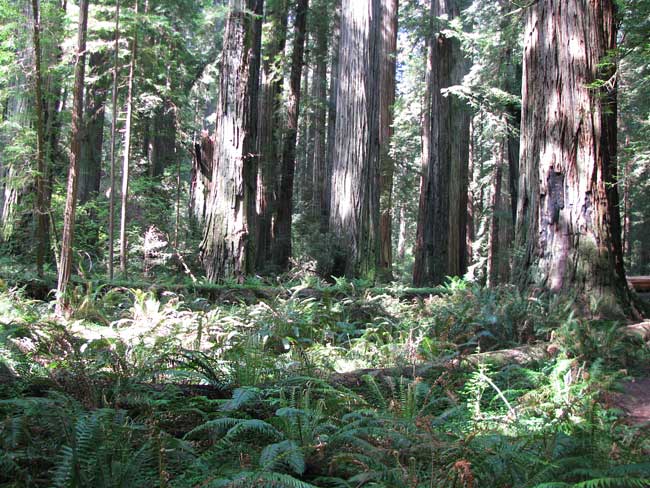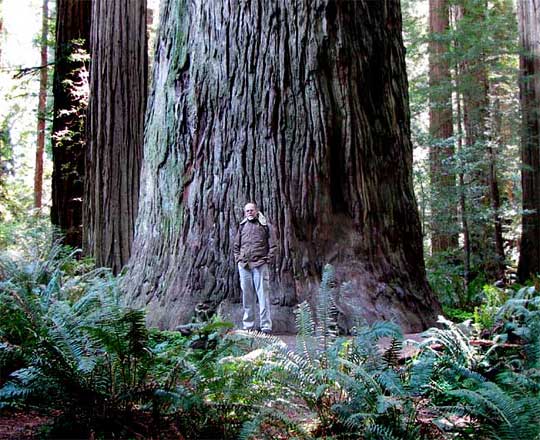Excerpts from Jim Conrad's
Naturalist Newsletter

from the the May 17, 2009 Newsletter, issued from the Siskiyou Mountains west of Grants Pass, Oregon:
IN A REDWOOD GROVE
Just south of the beach and across the state line in California, on a slope above Crescent City we visited a grove of Redwoods, SEQUOIA SEMPERVIRENS. You can see me standing before one of the giants in the obligatory visit-to-the-Redwoods tourist photo below:

In the picture I'm bundled up because it was cold. In fact, though the sun was shining there (the fog lay only over the beach all along the coast) the whole Redwood forest felt chill and somber. You can see a general shot showing many Redwood trunks and ferns at this page's top.
During the entire visit I heard only one bird, a woodpecker. In some places Redwoods and Swordferns were the only conspicuous species, the Swordferns being the same species I profiled in the May 3rd Newsletter, Polystichum munitum. However, in some places other species did appear: Tanoak, Madrone, Big-leaf Maple, California Bay and Red Alder. Redwood Sorrel (Oxalis oregana) occasionally formed clover- like carpets. Rhododendrons (R. macrophyllum and R. occidentale) were readying to flower.
Two differences between the Redwood groves and tropical rainforests I've been in caught my attention. First, Redwood trunks were not at all buttressed -- didn't have widely flaring bases helping the trunks stay upright. This lack of buttressing surely was connected to the second difference: the trunks were amazingly close together. I'll bet that these two observations are linked. By being close together Redwoods protect one another from winds and in a way hold one another up so that buttresses aren't need.
Redwoods belong to the same family as the US Southeast's Baldcypresses, the Taxodiaceae. Giant Sequoias not only belong to the same family but also the same genus, the genus Sequoia. About 40 species of Sequoia flourished in the Northern Hemisphere some 60 million years ago but today only Redwoods and Giant Sequoias remain, in California and Oregon.
REDWOOD BURLS
Many Redwood trunks bore large "burls," or gall-like growths the size of a car or larger. You can see Anita and a burl examining one another (as well as how a Redwood's trunk enters the soil with no buttresses) below:

Technically burls are known as lignotubers. Burl tissue occurs naturally at the base of normal young Redwood trees. Buds form inside the burls but remain dormant until fire or physical damage stimulates them to grow. Then shoots arise from the burls and grow rapidly using carbohydrates stored in the burl. Most second- and third-growth Redwoods remaining today were generated vegetatively from burls after 19th and 20th century logging. If Redwood reproduction depended solely on seed germination, which in Nature is very low, Redwood numbers would be only a small fraction of what they are today.
Unfortunately, if you cut across a burl the exposed wood shows interesting and beautiful swirling designs, so burls are often hacked off trees for furniture making or simply as curiosities, severely hurting the trees. The black market for burl wood, or "sliced Redwood" as it's called, is strong and much of it sold in gift shops and roadside stands was obtained illegally.
Some people plant Redwood burls wanting to grow Redwoods in their backyards. Invariably they water the sprouts too much water or in some other manner mismanage it, and the sprouts die. That white spot on the burl in my picture appears to be where someone has hacked off a piece of burl.
People simply need to leave the Redwoods and their burls alone.